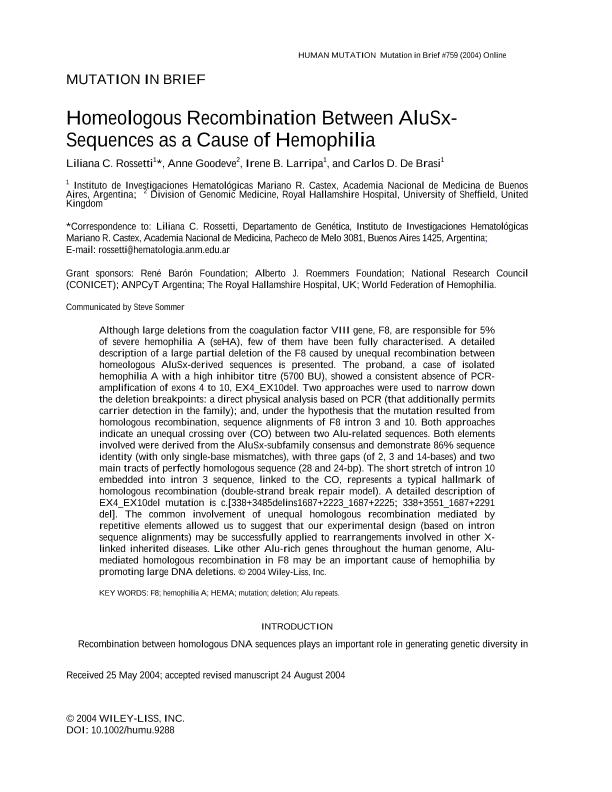Artículo
Homeologous recombination between AluSx-sequences as a cause of hemophilia.
Fecha de publicación:
12/2004
Editorial:
Wiley-liss, Div John Wiley & Sons Inc
Revista:
Human mutation
ISSN:
1098-1004
e-ISSN:
1059-7794
Idioma:
Inglés
Tipo de recurso:
Artículo publicado
Clasificación temática:
Resumen
Although large deletions from the coagulation factor VIII gene, F8, are responsible for 5% of severe hemophilia A (seHA), few of them have been fully characterised. A detailed description of a large partial deletion of the F8 caused by unequal recombination between homeologous AluSx-derived sequences is presented. The proband, a case of isolated hemophilia A with a high inhibitor titre (5700 BU), showed a consistent absence of PCR-amplification of exons 4 to 10, EX4_EX10del. Two approaches were used to narrow down the deletion breakpoints: a direct physical analysis based on PCR (that additionally permits carrier detection in the family); and, under the hypothesis that the mutation resulted from homologous recombination, sequence alignments of F8 intron 3 and 10. Both approaches indicate an unequal crossing over (CO) between two Alu-related sequences. Both elements involved were derived from the AluSx-subfamily consensus and demonstrate 86% sequence identity (with only single-base mismatches), with three gaps (of 2, 3 and 14-bases) and two main tracts of perfectly homologous sequence (28 and 24-bp). The short stretch of intron 10 embedded into intron 3 sequence, linked to the CO, represents a typical hallmark of homologous recombination (double-strand break repair model). A detailed description of EX4_EX10del mutation is c.[338+3485delins1687+2223_1687+2225; 338+3551_1687+2291 del]. The common involvement of unequal homologous recombination mediated by repetitive elements allowed us to suggest that our experimental design (based on intron sequence alignments) may be successfully applied to rearrangements involved in other X-linked inherited diseases. Like other Alu-rich genes throughout the human genome, Alu-mediated homologous recombination in F8 may be an important cause of hemophilia by promoting large DNA deletions. Copyright 2004 Wiley-Liss, Inc.
Archivos asociados
Licencia
Identificadores
Colecciones
Articulos(IMEX)
Articulos de INST.DE MEDICINA EXPERIMENTAL
Articulos de INST.DE MEDICINA EXPERIMENTAL
Articulos(SEDE CENTRAL)
Articulos de SEDE CENTRAL
Articulos de SEDE CENTRAL
Citación
Rossetti, Liliana Carmen; Goodeve, Anne; Larripa, Irene Beatriz; de Brasi, Carlos Daniel; Homeologous recombination between AluSx-sequences as a cause of hemophilia.; Wiley-liss, Div John Wiley & Sons Inc; Human mutation; 24; 5; 12-2004; 440-450
Compartir
Altmétricas




